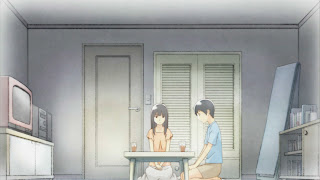The second episode of Hourou Musuko was just as wonderful as the first, if a bit more low-key emotionally. While no single scene packed the massive punch that the bridge scene in the premiere did, this was a great slice-of-life that went a long way towards introducing the various cast members of import.
One thing I’ve found really striking in the series so far is just how vividly each character is drawn. Shu and Yoshino are obviously the leads – and two of the best of any anime for a long time – but each of the major supporting cast jumps off the screen as real, complex people. We met most of them in the premiere but several has much more important roles to play this week, as the beginnings of the middle school social structure started to fall into place. Most important is probably Saori Chiba, a surly little classmate who has a serious crush on Shu. Just as the premiere slyly referenced back to the confession that temporarily estranged Shu and Yoshino, in this episode the same method is used to illustrate the rift between Yoshino and Saori. Saori says she hates Yoshino because Shu confessed to her, but we’re teased with references to earlier conflicts between them caused by Saori demonizing Yoshino. Unfortunately this estrangement has severely upset their mutual friend Sasa, an innocent and genki girl who clearly takes discord between her friends to heart.

Meanwhile Shu and his best friend Makoto are adjusting to live as middle schoolers. Mako is like Shu in that he feels feminine gender impulses, but unlike Shu he finds himself attracted to males. Both are outcasts among the boys and find solace in the others’ accepting nature, though one can sense a tension underlying their friendship. Where Shu is an emotional child Makoto seems much more analytical about their situation – at this point he’s an observer more than a participant in what’s happening around him. Quite the opposite is Chizuru Sarashina who, despite her large stature calls herself “Chi-chan” and is the constant life of the party. She became an object of interest for Shu and Yoshino by wearing a boy’s uniform in the premiere, though she shows up in a girl’s this time. Chi-chan seems to want to get along well with everyone, and eventually invites herself and her best friend Momo along when Sasa, Yoshino, Saori and the boys walk home from school together after a detente engineered by Yoshino. Against this backdrop we also have Shu’s onee-san Maho and her male classmate Riku, who clearly fancies her – though Maho resents that he initially mistook Shu for a girl and thought he was “cute”. Maho seems to resent just about everything, frankly – she’s definitely the villain of the piece thus far for her general cruelty towards her brother, though even she has already come off as a complicated person.
It’s a tribute to the manga-ka that these are such interesting characters, but even more so to the team at AIC that they’ve managed to pull off a little miracle here. Despite skipping 30+ chapters and dumping us off in the middle of the story, they’ve managed to give us an excellent picture of who each of the kids are – how they got to be that way, their hopes and faults and hot buttons. After an initial bit of confusion just based on how many characters are important to the story I haven’t had any trouble following the episodes at all – and I really think that’s because each of these characters has been fleshed out so beautifully already. To do that in two episodes using only very occasional flashbacks and voice-overs is amazing – it all happens by placing the kids in realistic situations and letting us observe their reactions. It’s great storytelling on any terms, but within the confines of the 11-episode series length it’s astonishing.
As things stand now, Shu – as Makoto points out in the last line of the episode – is falling harder for Yoshino than ever. That lends a note of caution to the situation, which otherwise looks better at the end of the episode than one might have hoped. The kids have formed a social group, Shu and Yoshino have reconciled, things have cooled off a bit with Saori and Chi-chan looks to be a wonderful tension-reliever for the social dynamics of the group. But this is still a story of a boy who wants to be a girl in love with a girl who wants to be a boy, so things are quite naturally going to stay very complicated. But remarkably for all that the series isn’t really about the cross-dressing and the gender confusion – it’s about the kids and the very normal emotional struggles and joys they’re undergoing as they enter adolescence. And if there was ever a timeless subject for a story, that’s it.





